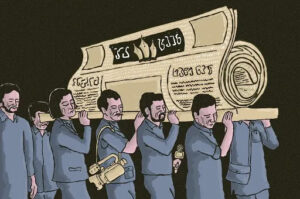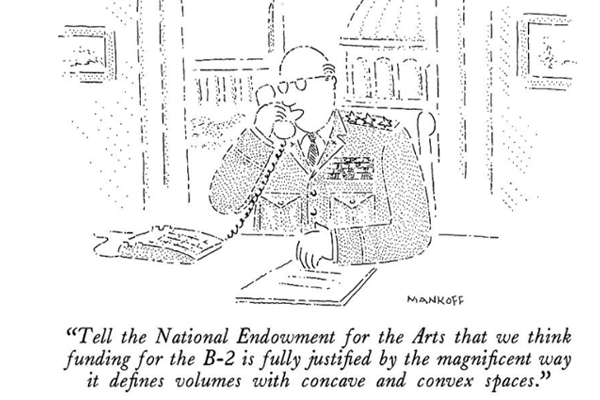
Disappearing media
This is the 199th edition of SHuSH, the official newsletter of the Sutherland House Inc.

The Canada Council is in the midst of devising a five-year strategic plan that will influence its annual distribution of a half-billion dollars to Canadian artists and cultural organizations. Naturally, it held consultations as part of its planning process, as all creatures of government do these days (the council is a crown corporation). A question for you: if you were in charge of giving away a half-billion in public money, who would you consult with before deciding what to do with it? Me, I’d start with the public. After all, it’s their money. And if there is any justification for giving their hard-earned money to fund arts and culture, surely it starts with the expectation of a public benefit of some sort. The benefit might be edification. It might be entertainment. It might be economic. But the public out to benefit, and it ought to have a say in how it is to be benefitted. That’s not where the Canada Council went looking for input. The main piece of research informing its strategic plan is a survey of 6,122 people. Half are artists. Another 30% are arts organization staffers and “arts enthusiasts.” It’s not clear who the rest are but it’s safe to say that at least 80% of those consulted are stakeholders, or interested parties, as distinct from the general public. The survey is supplemented by special meetings with a couple of hundred people, a mix of arts types and special interest lobbies: “youth, Indigenous peoples, culturally diverse groups, Deaf and disability groups, and official language minority communities, as well as National Arts Service Organizations and other arts service organizations.” Also, the council hired Hill & Knowlton to ask 1,002 members of special interest communities— “youth (18-34) and culturally diverse populations”—what they want from arts and cultural programs and initiatives. Finally: “In addition to the engagement activities led by H+K, the council conducted a series of dialogue sessions with Indigenous stakeholders and experts on the topic of decolonizing arts funding.” And: “Through the summer of 2020, the council held a series of dialogue sessions with its staff, exploring topics affecting the arts sector, including climate change, sustainability, and anti-racism, etc.” So, unless they’re hiding it, the council did not ask the public what it wants. Why does that matter? Because the survey results make plain that the arts community has a problem with the broader community. Respondents were asked to identify the most significant barriers to improving engagement with the arts in Canada. After the immediate pandemic-related issues of closed venues and health-and-safety concerns, the major problems cited were difficulties in capturing the attention and dollars of potential audiences: Asked to identify the most significant barriers to making arts in Canada, the top four answers from respondents again referenced money and audience: Clearly, then, the biggest problem facing the arts-and-culture community in Canada is the lack of interest and financial support from the broader public, but god forbid the unwashed be involved in these consultations.Rather than making an honest attempt at public engagement, the council went to considerable effort and expense to create its own filter bubble, collecting information and opinions that conform to and reinforce its own beliefs, furthering its isolation from the audiences it desperately needs. More evidence that the Canada Council is hopelessly out of touch came from its annual public meeting last month. This, presumably, was an opportunity for the council to be accountable to the public.
How did it go? One of its two top leaders, Jesse Wente (above), the incoming chair, had nothing to say about any of the above-mentioned priorities of his stakeholders or the desperate economic situations artists find themselves in at the moment. Rather, he wanted to talk politics. He articulated what amounts to an alternative strategic plan reflective of his personal political priorities:
This journey has brought us to a moment where inequities should be obvious to all. Where anti-Black and anti-Indigenous racism has once again been laid bare for all to see and for all to work against.
This while the world continues to grapple with the ongoing pandemic, which itself has only further exacerbated existing inequalities.
We are at an inflection point, perhaps more than one, and while there is much to navigate, we are nonetheless presented with the opportunity to change, and to do so boldly. The arts are well positioned to lead this change, as it has already started, and artists are always at the forefront of guiding us beyond inflection moments.
For Wente, the pandemic is notable less for its catastrophic economic impact on artists than as an opportunity to score political points. Call it disaster activism.
Unlike Wente, Simon Brault, CEO of the Canada Council, seemed to hear among his stakeholders “a strong desire for increased, predictable, diverse and sustainable funding.” But he, too, was keenest on advancing a political agenda. The council, he said, must “seek to advance diversity, inclusivity and our social responsibilities, namely on the social and climate justice fronts, both within and outside our sector.” The bold type is his, underscoring world-class mission creep.
The first two elements of the council’s evolving strategic plan Brault (below) chose to emphasize were “an increased presence of Indigenous perspectives in all the Council’s activities and policies, while we continue to progress in our own decolonization process, which we want to be consistent and exemplary.”
And, “We will work with the communities most affected by systemic racism in order to address its presence and impact in both the Council and the wider arts sector.”
I don’t have a problem with individual artists or arts organizations making political statements or promoting political values. I do think it’s a problem when a government-sponsored arts funding body gets political. It trips a wire between support for the arts and regulation of the arts and artists. The initial impulse to help is perverted into an impulse to direct. Once the bureaucrats start directing, artists, who quite properly revel in their intellectual and artistic freedom, are reduced to pawns of an official project to shape a political climate.The Canada Council was established as a crown corporation, arms-length from government, precisely to protect it from political interference from government officials (particularly the elected variety), preserving the freedoms of the arts community. The idea was to elevate the arts above politics.It was a nice idea but the downside of that arms-length relationship is that it leaves appointed (unelected) officials such as Messrs. Brault and Wente free of government oversight, unaccountable to the public, and at liberty to pursue their own ambition to subordinate arts to politics.
Everyone who accepts Canada Council money is implicated in the Wente-Brault crusade, whether they like it or not. I suspect that some artists don’t mind because they agree with the Brault-Wente political program. But that’s short-sighted. All this politicking creates an unfortunate precedent for the next government that comes to power. As I’ve written elsewhere, Conservatives will owe it to his supporters to impose their own political agenda on the arts. Have fun advancing law-and-order and pipeline capacity through creative activities.There is no evidence of broad-based support for the Brault-Wente agenda in the council’s own surveys. Less than a quarter of respondents believed systemic discrimination was a significant barrier to making art in Canada, 7% cited “activism, social change, and cultural critique” as a reason that the arts were important to them, and 1% wanted the arts in Canada to play a leadership role on social justice issues.\”
Rather, there is good evidence that the stakeholders think the council has lost its way. In response to leading questions of the tell-us-how-good-a-job-we’re-doing variety, a mere 24% said the council has made a significant impact on advancing the arts in Canada. Only 9% said current funding models are working well. Still, there was no suggestion at the public meeting that the council was anything but a runaway success.
A responsive, accountable Canada Council would have noted the desperate economic challenges facing the arts community and focused all of its efforts and messaging this year on bringing relief. Not these dudes. They’ve got well-paid jobs. They’re secure in their filter bubble. Nothing is going to get in the way of their personal political priorities.
Wente and Brault sucked up most of the time at the “public meeting,” allowing only three or four polite, hand-picked questions at the end. It was a parody of accountability that would have made any Fortune 500 company proud.
On they go with their grand strategery. Sure to set back Canadian arts-and-culture for another five years.

This is the 199th edition of SHuSH, the official newsletter of the Sutherland House Inc.

There was an interesting piece in the New York Times a week or so ago about James Daunt (above), the incoming chief executive of Barnes & Noble, the most important bookstore chain in the English-speaking world. It didn’t quite get to the nub of the matter. Barnes & Noble has

The world of non-fiction from Sutherland House ( and Beyond )